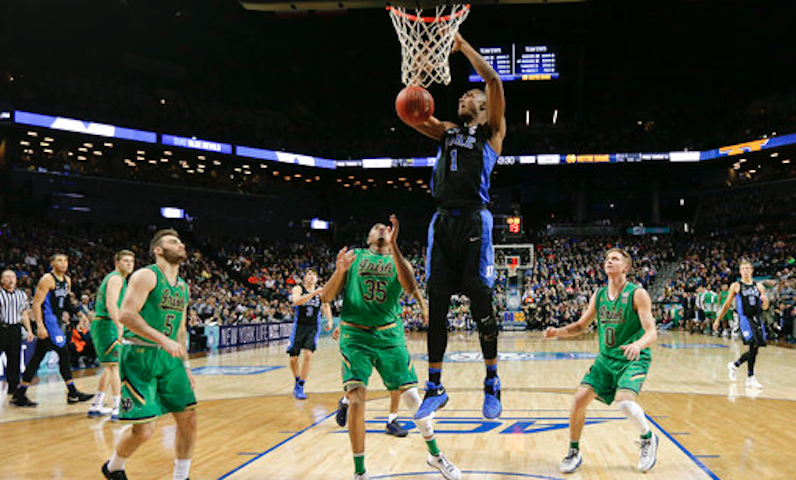Two weeks ago, we looked at how Harry Giles displayed up in Brooklyn that he has the tools necessary to become a ridiculous talent. It was a look into the numbers behind why NBA teams would target a player who spent just 300 minutes on the court this season.
Now that Duke’s 2016-17 campaign has ended, we can turn our attention to which players will return to Durham next season. Jayson Tatum has already declared for the draft. Here’s a look at why it makes sense for Giles to declare for the NBA Draft, despite a modest and injury-plagued freshman season.
Looking for value — both high and low
The name of the game for NBA teams is to find talent in the first round. It’s been empirically proven that draft picks inside the top 10 selections are far more likely to go on to various levels of superstardom: All-Star appearances, All-NBA selections, max contracts. It is imperative that teams with lottery picks (the first 14 selections of the draft) hit home runs. This is the easiest and cheapest way to collect star players.
However, for teams drafting outside of that range, there’s a premium on adding value. The San Antonio Spurs have sustained a dynasty for 20-plus years by finding players late in the first round — their annual draft vantage point — who can contribute.
Giles was projected as the No. 1 overall pick, which changed after his injuries. If a team drafting late in the first round can find a player who was once coveted as a rare prospect, then that becomes an incredible value find.
Franchises that draft at the back end of the first round are usually playoff teams that have pricey payrolls. It can be tricky to keep a core together, especially as players enter free agency looking for paydays. The NBA has a soft cap, but there are still penalties and limitations on spending. One way for these teams to keep things going is to find cost-controlled players late in the first round. Giles fits the mold.
For the sake of convenience and comparison: DraftExpress currently projects Giles as the No. 24 selection — going to the Utah Jazz. The Jazz are a playoff-bound team that has several roster moves looming on the horizon. Salt Lake City is not a free agent destination, either. Hypothetically, Giles presents an opportunity to get a superstar-level talent at a below-market rate.
Patience is more than a virtue; it’s pragmatic
When a team spends a first-round pick on a player, it possesses the rights to that player for the next four years, at a minimum, if it so chooses. Of course, there are exceptions, like Josh Huestis and P.J. Hairston, but for the most part teams control that player for at least four years. The franchise also has advantages over resigning that player with his Bird rights. Under the newly ratified CBA, teams that draft players could potentially control the path of that player for the next 14 seasons.
With this being the case, whichever team selects Giles does not have to worry about playing him right away. He can sit for a year, or whatever length of time is deemed necessary for him to get as close to 100 percent healthy as possible.
NBA teams are putting more emphasis than ever before on player health and rest. The team that drafts Giles does not have to sweat tossing him into a playoff run or having him play 28 minutes per night on a lottery-bound squad. The return does not have to be immediate.
This is also why NBA teams are still bullish on Indiana swingman OG Anunoby, who suffered a season-ending knee injury in January but is still projected as a mid-first-round pick.
More money, fewer problems
The NBA’s new CBA, which once again included the one-and-done rule, will allow for an increase in rookie contract salaries. What NBA players make as first-round picks is slotted; we already know years in advance what the No. 8 pick in the 2018 draft will make. We know what that player will make in Year 1 and how that annual salary will increase over the duration of the contract.
Rookie contracts will increase — starting with the 2017 draft class. Some estimates believe the rookie deals will increase by 50 percent. These are factors that Giles is likely aware of.
There are very few first jobs that can offer you the opportunity to become a millionaire right out of college. NBA first-round picks fall under this category, and the money is only getting better.
Brice Johnson was the 25th pick in 2016. That came with a slotted first-year salary of $1,061,600. Players are allowed to sign for up to 120 percent of their rookie scale figure, which is why he’s making close to $1.3 million this season. The initial figure, however, could now balloon up another $500,000-plus under the new CBA.

















